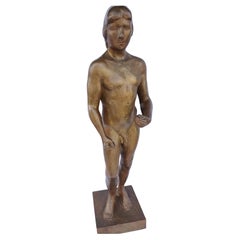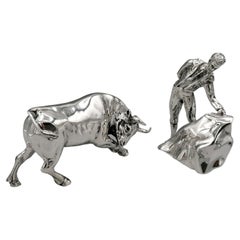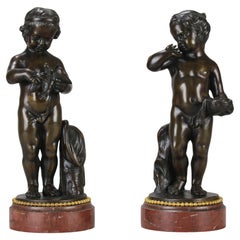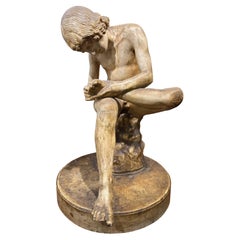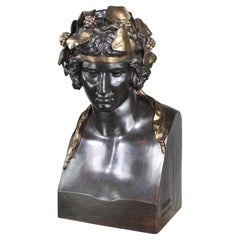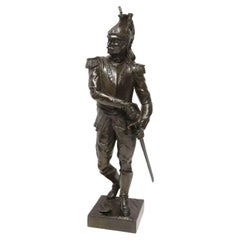Cast Figurative Sculptures
to
193
1,109
112
27
37
333
739
139
327
199
114
40
25
63
52
14
22
24
23
23
33
236
102
73
51
40
33
13
12
11
10
8
6
5
5
4
2
2
1
1,093
872
241
165
71
650
417
798
346
203
175
129
Height
to
Width
to
1,248
1,190
1,231
28
26
14
10
9
Technique: Cast
Midcentury Bronze Sculpture of a Nude Male Foundry Guss Barth Rinteen
Located in Port Jervis, NY
Fabulous bronze of a tall large nude Male. Arms extending forward. Foundry stamp Guss Barth Rinteln. Large 29.5 tall and heavy. In excellent condition.
Category
1950s European Modern Vintage Cast Figurative Sculptures
Materials
Bronze
20th Century Italian Sterling Siver Bull and Bullfighter Sculpture
Located in VALENZA, IT
Solid sterling silver bull and bullfighter miniature.
Both the bull and the bullfighter were made with the casting technique and then chiseled to bring out the details.
The precisi...
Category
1980s Italian Other Vintage Cast Figurative Sculptures
Materials
Sterling Silver
Late 19th Century Art Nouveau French Bronze entitled "Boy and Girl"
Located in London, GB
A charming pair of late 19th Century bronze studies of a two young children one holding a bowl whilst the other holds a bird with excellent hand chased surface detail and very fine r...
Category
Late 19th Century French Art Nouveau Antique Cast Figurative Sculptures
Materials
Bronze
A Plaster Cast of the Spinario or ‘Boy with Thorn’, 19th Century
Located in ARMADALE, VIC
A Plaster Cast of the Spinario or ‘Boy with Thorn’, 19th Century
Description:
The plaster cast after the original ‘Spinario’ now housed in the Palazzo dei Conservatori (Rome), also ...
Category
19th Century Italian Antique Cast Figurative Sculptures
Materials
Plaster
Monumental French 19th Century Cast-Iron Bust of 'Head of Antinous as Dionysus'
Located in Los Angeles, CA
A Monumental French 19th Century Patinated and Parcel Gilt Cast-Iron Bust of 'Head from a Statue of Antinous as Dionysus' Wearing a Wreath of Ivy ...
Category
19th Century French Greco Roman Antique Cast Figurative Sculptures
Materials
Iron
19th Century Bronze Study of a French Military Figure by L. A Bayeux, circa 1890
Located in Central England, GB
A Fine Bronze Study of a French Military Figure by L. A Bayeux
This finely modelled French bronze depicts a striking French early 19th century military figure stood dressed in ful...
Category
19th Century French Antique Cast Figurative Sculptures
Materials
Bronze
"Snake Dancer", Fine Art Deco Sculpture w/ Female Nude, Lighted Alabaster Base
Located in Philadelphia, PA
Extremely rare and very finely cast, this gilded bronze sculpture of a snake dancer in harem clothes -- but with a modern 1920s hair style -- was sculpted by Raymond Delamarre...
Category
1920s French Art Deco Vintage Cast Figurative Sculptures
Materials
Bronze
$8,800 Sale Price
20% Off
Sigge Berggren, Swedish Modernist Nude Bronze Sculpture, 1940s
Located in Skanninge, SE
A young nude woman on her knees.
Cast in bronze and patinated in dark brown. Signed "Berggren".
Sigge Berggren (1911-1968) was a Swedish sculptor ...
Category
Mid-20th Century Swedish Scandinavian Modern Cast Figurative Sculptures
Materials
Bronze
Hollywood Regency Sculptural Brass Pineapple Table Lamp Style of Maison Charles
Located in Verviers, BE
Gorgeous table lamp with golden base
Made in France during the 1960s in the style of Maison Charles.
In excellent condition (Original Patina) and in full working order
With fittin...
Category
1960s French Hollywood Regency Vintage Cast Figurative Sculptures
Materials
Brass
Early 20th Century Art Nouveau Bronze Sculpture "The Fencer" by Rudolf Küchler
By Rudolf Kuchler
Located in London, GB
An impressive Austrian bronze study of a muscular fencer in mid lung with excellent golden patina and very fine hand finished surface detail, raised on a decorative integral base, si...
Category
Early 20th Century Austrian Art Nouveau Cast Figurative Sculptures
Materials
Bronze
"Double Play, " Sculpture Capturing Dramatic Baseball Play with Male Nude, 1953
By Joe Brown
Located in Philadelphia, PA
A brilliant piece of sculpture capturing one of the most dramatic moments in American baseball, this 1953 bronze by Joe Brown shows a baseball player touching second base with his right foot and readying to throw the ball to first base for the second out with his right arm. The figure is cantilvered over the wood base, and the placement of his arms and legs is dancelike in its grace and strength. Brown has captured the tension of his torso and limbs and the beautiful musculature of the man's back, reminding the viewer that he learned from the master of American athletic sculpture...
Category
1950s American Mid-Century Modern Vintage Cast Figurative Sculptures
Materials
Bronze
$7,800 Sale Price
20% Off
Art Deco Figurine, Fine Casting and Marble, the Favorite after Chiparus
Located in Los Angeles, CA
A fine detailed casting of a dancer by the artist dh Chiparus, has the mark on the base plate. All solid marble base. After the original and is super detailed and patina finish. A he...
Category
1980s North American Art Deco Vintage Cast Figurative Sculptures
Materials
Bronze
"Gladiator with Shield and Helmet, " Rare, Large Bronze Sculpture with Nude Male
By Bruno Zach
Located in Philadelphia, PA
The first example of this sculpture we have seen, this striking depiction of a male gladiator -- clothed in nothing but a short mail skirt - is shown in the midst of battle, one arm ...
Category
1910s German Beaux Arts Vintage Cast Figurative Sculptures
Materials
Bronze
Pair of Japanese Cast Bronze Figures of Niō, Meiji Period, Late 19th Century
Located in Austin, TX
A well cast pair of Japanese mixed metal okimono figures of Buddhist guardians, known as Nio or Dharmapala, protectors of Buddhist faith, Meiji Period, Japan.
The smiling bronze g...
Category
Late 19th Century Japanese Meiji Antique Cast Figurative Sculptures
Materials
Bronze
Frederico Cantu Large Impressive 1986, Bronze of a Mother Nursing
Located in Palm Springs, CA
A large and impressive work by the California or Mexican noted artist Frederco Cantu (1907-1989). It is signed and dated 1986. Quite large and heavy.
A brief bio follows from askant:
Federico Cantú...
Category
1980s American Modern Vintage Cast Figurative Sculptures
Materials
Bronze
$9,375 Sale Price
25% Off
Central Javanese Cast Silver Transcendent Buddha, 9th-12th Century, Indonesia
Located in Austin, TX
An exceedingly rare Javanese cast silver figure a Transcendent Buddha, probably the Dhayani Buddha Akshobhya, early classical Javanese period, 9th - 12th century, Java, Indonesia.
...
Category
15th Century and Earlier Javanese Antique Cast Figurative Sculptures
Materials
Silver
James Gabbert (American, B. 1952) Bronze Of A Woman, "Dusk", Signed
Located in Bridgeport, CT
Bronze figure of a barefoot woman emitting from a flower with her hair and fold of her dress in the air. The piece has a very fine movement and lightness. Signed on base.Presented on...
Category
20th Century American Art Nouveau Cast Figurative Sculptures
Materials
Stone, Bronze
Bronze Figural Angel Bird Bath
By Franz van Severdonck
Located in London, GB
A Beautiful Cast Bronze Cupid Bird Bath in the Manner of Franz Von Stuck
The Cupid Holding the Decorated Shell shaped bowl
Ideal for outdoors or in
Category
Late 20th Century Unknown Country Cast Figurative Sculptures
Materials
Bronze
Sculpture by Klara Sever for Austin Productions, 1970's
Located in San Juan Capistrano, CA
Sculpture by Klara Sever for Austin Productions, 1970's.
Category
20th Century American Brutalist Cast Figurative Sculptures
Materials
Plaster
$520 Sale Price
20% Off
Classical Bronze Tabletop Statue of a Putto Holding a Frog
Located in Yonkers, NY
A lost-wax bronze tabletop statue of a putto poised on one foot holding a frog up in the air. This classic bronze tabletop sculpture is mounted on a modern round custom base, making ...
Category
Mid-20th Century Cast Figurative Sculptures
Materials
Bronze
Art Deco Figurine, Female Javelin Thrower
Located in Los Angeles, CA
A very well cast sculpture of a Female Athlete in full action pose. Title is (Amazone Au Javelot ) in French. The Amazon Girl! Lost wax bronze with multi patina's. Possibly by the Ar...
Category
1990s American Art Deco Cast Figurative Sculptures
Materials
Bronze
20th Century Art Deco Study entitled a"Femme a la Palme" by Demetre Chiparus
Located in London, GB
A fabulous and very large early 20th Century silvered and gilt bronze figure of an Art Deco beauty holding a palm branch above her head, a particularly rare subject from this famous ...
Category
Early 20th Century French Art Deco Cast Figurative Sculptures
Materials
Bronze
Carl Schmitz Plaster Sculpture, circa 1940
By Carl Schmitz
Located in Sharon, CT
Schmitz was an important German-American figurative sculptor of the 1930s-1940s. Studied with J.Wackerle. Commissions include: Brooklyn B...
Category
1940s American Art Deco Vintage Cast Figurative Sculptures
Materials
Plaster
"Virgo, " Rare, High Style Art Deco Bronze Bas Relief by Paul Manship
By Paul Manship
Located in Philadelphia, PA
Boldly and brilliantly sculpted in high relief, this depiction of the classic symbol of the Zodiac sign of Virgo. A nude female figure with a sheaf of wheat -- was sculpted by Paul M...
Category
1940s American Art Deco Vintage Cast Figurative Sculptures
Materials
Bronze
Early 20th Century Art Deco Bronze Study "Scarf Dancer" by Josef Lorenzl
Located in London, GB
An attractive early 20th Century Art Deco cold painted silver and blue enamel bronze figure of a young energetic beauty in a dancing pose with a scarf draped around her midriff. The ...
Category
Early 20th Century Austrian Art Deco Cast Figurative Sculptures
Materials
Bronze
Set of 3 Bill Curry Gold Bronze Finished Cast Iron Jacks Sculptures Atomic Age
Located in Miami, FL
Set of 3 Jack Sculptures, Door Stopper, Paperweight or decorative accent pieces, designed by Bill Curry of Design Line, 1967.
Features a Mid-Century Modern atomic, geometric shape ma...
Category
Late 20th Century American Space Age Cast Figurative Sculptures
Materials
Iron
Cast Bronze and Marble Shepherdess with Sheep Sculpture Signed D. Alonzo
Located in Buenos Aires, Buenos Aires
Cast bronze and marble shepherdess with sheep sculpture signed D. Alonzo. France, early 20th century.
Category
Early 20th Century French Art Nouveau Cast Figurative Sculptures
Materials
Marble, Bronze
Antique Figural Cast Bronze Dinner Bell with Upset Woman & Shoed Leg Clapper
Located in Hamilton, Ontario
This antique whimsical cast bronze figural bell is unsigned and has no foundry mark, but is presumed to originate from the United States and date to appro...
Category
Late 19th Century American Victorian Antique Cast Figurative Sculptures
Materials
Bronze
Art Nouveau Polychromed Metal Sculpture "Romantic Beauty" by Arthur Waagen
Located in London, GB
An impressive late 19th century polychromed bronzed metal sculpture of an Orientalist maiden resting on a twin handled jardinière with excellent hand chased surface detail and fine naturalistic colours, signed Waagen
Arthur Waagen (German, 1833-1898) was born at Memel in Prussia, was a little-known German Animalier and orientalist figurative sculptor. Early in his career he moved to Paris, where he settled permanently to persue a career as a sculptor. His studio was based at 40, Cours de Vincennes, east of Place de la Nation. Inspired by the trend for the oriental, he exhibited several works with north African themes...
Category
1890s German Other Antique Cast Figurative Sculptures
Materials
Metal
Nude Bronze Sculpture by James Maher
Located in New York, NY
James Patrick Maher (20th Century), bronze Sculpture of a nude woman.
James P. Maher, was a renowned artist whose drawings, paintings and sculptures reflected an innate appreciation...
Category
1970s American Mid-Century Modern Vintage Cast Figurative Sculptures
Materials
Bronze
Marcel Andre Bouraine Art Deco Silvered Bronze Lighted Sculpture Dancing Girl
Located in Hamilton, Ontario
This rare and extremely well executed bronze statue was done by the highly renowned French artist Marcel Andre Bouraine in circa 1925 in the period Art Deco style. This bronze is kno...
Category
Early 20th Century French Art Deco Cast Figurative Sculptures
Materials
Onyx, Bronze
Gilt And Patinated Bronze Bust By Henri Godet “Femme Tulipe”
By Henri Godet
Located in Norwood, NJ
A fine unusual Art Nouveau two tone gilt and patinated bronze bust of a young lady rising from the center of a tulip flower with fine detail, raised on a breche griotte circular marb...
Category
Early 1900s French Art Nouveau Antique Cast Figurative Sculptures
Materials
Griotte Marble
A Bronze Statue of "Boy with Rooster " after Adriano Cecioni ( 1838-1886)
Located in Vancouver, British Columbia
A bronze statue of a young boy standing and holding a tethered rooster with wildly flapping wings in his arms. The boy is presumably in a farmers' market and his expression shows him screaming at the top of his lungs trying to sell the rooster. The boy is leaning against a standing wooden wheelbarrow...
Category
20th Century Italian Napoleon III Cast Figurative Sculptures
Materials
Bronze
Silver Figures of Eight Immortals Yangqinghe Jiuji Marks, Late Qing Dynasty
Located in New York, NY
Important and rare silver figures of eight immortals Yangqinghe Jiuji marks, Late Qing dynasty. Each hollow figure portraying one of the immortals in an animated pose, with highly detailed facial features, four pierced with apertures for the insertion of facial hair, clad in finely chased robes, all but two with their characteristic attributes, their bases bearing either two seal marks reading Yangqinghe Jiuji gongyibu and Zhe'ning Hu Qiusheng zao, or three marks in regular script reading Yangqinghe Jiuji gongyibu, Shang and Sheng zuo, original hand-carved wood stands. Measures: 11 1/4in (28.5cm) high (tallest one).
The earliest records of the silver atelier known as Yangqinghe date to 1775 in Shanghai...
Category
1890s Chinese Chinese Export Antique Cast Figurative Sculptures
Materials
Silver
Art Deco Male Patinated Bronze Study Entitled 'Power Lifter' by Bruno Zach
By Bruno Zach
Located in London, GB
A dramatic early 20th century Art Deco bronze study of a muscular male athlete lifting a heavy weight above his head with one arm. The bronze exhibiting stunning rich brown patina an...
Category
20th Century Austrian Art Deco Cast Figurative Sculptures
Materials
Bronze
Edmont Moirignot Paris Sculpture Poseidon Neptun Trident Bronze
Located in Munich, DE
We admire a very expressive sculpture of the ancient god of all the seas, Poseidon, standing proud and confident on a wave, holding a trident in his right hand.
Edmont Moirignot (Pa...
Category
1950s French Mid-Century Modern Vintage Cast Figurative Sculptures
Materials
Bronze
Antique Pair of 1920's Art Deco German Moch Mannequins
By Moch Figuren
Located in London, GB
Antique Mannequins, Vintage Mannequins, 1920's Mannequins, Art Deco Antiques, German Youth Mannequins, German Cabaret Mannequins, Antique Artist Lay Figures.
Antique Pair of 1920s A...
Category
1920s German Art Deco Vintage Cast Figurative Sculptures
Materials
Metal
Antique Bronze Clasped Hands By Sylvain Norga
Located in Stamford, CT
Cast bronze clasped hands by Sylvain Norga. Belgium circa 1915. Norga was known for his religious themed castings. This piece would have been mounted to an object or structure. Extre...
Category
1910s Belgian Baroque Revival Vintage Cast Figurative Sculptures
Materials
Bronze
Nymphenburg Limited Edition Skull - Voyage - hand painted Nr. 18/25
Located in München, Bavaria
Nymphenburg Porcelain limited edition skull - Voyage - attributed to the modern nomad, sailing fanatic or nautical expert. This hand crafted and hand painted skull is a perfect examp...
Category
2010s German Organic Modern Cast Figurative Sculptures
Materials
Porcelain
Mid 19th Century Animalier Bronze entitled "Faisan Tournée à Droite" by P J Mêne
Located in London, GB
A very fine mid 19th Century Animalier bronze study of an alert pheasant with its head raised and turned to the right with rich brown lightly rubbed patination and fine hand finished...
Category
Mid-19th Century French Art Nouveau Antique Cast Figurative Sculptures
Materials
Bronze
Mid Century Modern/Art Nouveau , Bronze , pair , Lady Figurines
Located in Los Angeles, CA
Highly detailed lost wax Bronze castings made after the Original pieces as a pair of Elegant dressed Lady's all finished in multi-patinas and mounted on absolute Black marble bases ...
Category
1990s American Art Nouveau Cast Figurative Sculptures
Materials
Bronze
Very Large Spelter Orientalist Sculpture Attributed to Hottot
By Louis Hottot
Located in London, GB
Very large spelter Orientalist sculpture attributed to Hottot
French, Late 19th Century
Height 194cm, width 84cm, depth 75cm
This sensational life-size figural group depicts a femal...
Category
Late 19th Century French Islamic Antique Cast Figurative Sculptures
Materials
Bronze, Spelter
Early 20th Century Art Nouveau Bronze "Putto Jug" by Georges Van De Voorde
Located in London, GB
A charming early 20th Century bronze vase decorated with a dragon appearing from a lake, its body in the of the vase handle and a putto pearing round the corner with excellent colour...
Category
Early 20th Century Belgian Art Nouveau Cast Figurative Sculptures
Materials
Bronze
Palatial French 19th-20th Century Allegorical Figural Cast Iron Group Torchere
Located in Los Angeles, CA
A very fine and palatial French 19th-20th century allegorical figural cast-iron group torchere - sculpture - fountain - representing spring and the harvest, probably cast by Le Fonderies d'Art du Val d'Osne. The charming four-putti sculpture with a front standing putto holding a pole amongst wheat stalks, another putto kneeling and collecting wheat, a third one wearing a hat and picking flowers for a wreath and the fourth kneeling putto holding a bird's nest, all below an elongated classical stem with a glass globe (Electrified), circa: Paris, 1900.
Overall height: 84 inches (213.4 cm).
Width: 29 1/2 inches (74.9 cm).
Circular base diameter: 24 inches (61 inches).
Cast-iron had been in production during the 18th century but its inferior status to the more fashionable and delicate wrought-iron had generally confined its use to architectural work. By the early 19th century, however, rapid developments of the Industrial Revolution combined with the simultaneous burgeoning of a new middle class provided the impetus for a dramatic expansion in its application and in a short space of time a proliferation of iron foundries across Europe and America thrived on the production of everything from inkstands to railway stations. The use of cast-iron for garden ornament became particularly widespread at this time, as the possibilities for its mass-production at a fraction of the cost of bronze made it the material of choice for outdoor statuary...
Category
Early 1900s French Rococo Antique Cast Figurative Sculptures
Materials
Iron
$34,850 Sale Price
59% Off
A Bronze Figure of Napoleon, 19th Century
Located in ARMADALE, VIC
A Bronze Figure of Napoleon, 19th Century
Provenance:
Private Melbourne Collection.
Description:
In full military dress, his sword sheathed and arms folded over his chest, his ri...
Category
19th Century French Empire Antique Cast Figurative Sculptures
Materials
Bronze
19th Century Art Nouveau Bronze Sculpture "Fille au Puits" by Auguste Moreau
Located in London, GB
A very fine late 19th Century Art Nouveau bronze figure of a young girl sat upon a well feeding a small bird, exhibting excellent rich brown variegated patina and very fine hand fini...
Category
Late 19th Century French Art Nouveau Antique Cast Figurative Sculptures
Materials
Bronze
Early 20th Century French Bronze Sculpture with Marble Base of a Sitting Boy
Located in North Miami, FL
Early 20th century french bronze sculpture with marble base of a sitting boy
By: unknown
Material: copper, bronze, metal, ...
Category
Early 20th Century French Belle Époque Cast Figurative Sculptures
Materials
Marble, Metal, Bronze, Copper
Pair of 19th Century French Patinated Bronze Models of the Marly Horses
Located in Long Island City, NY
Pair of 19th century French patinated bronze models of the Marly Horses.
Category
1870s French Napoleon III Antique Cast Figurative Sculptures
Materials
Bronze
Tom of Finland. Bookend ‘Durk’
Located in Los Angeles, CA
Tom of Finland. Bookend ‘Durk’
Bookend, painted cast resin, height 12.8 in., base 6 x 6 x 0.8 in.
Always Ready to Handle the Heaviest Load- Get Your Books Sandwiched and Add Some Pl...
Category
21st Century and Contemporary Italian Cast Figurative Sculptures
Materials
Resin
$469 / item
Modern/deco Sculpture Ballerina
Located in Los Angeles, CA
One of the most popular Art Deco figurines designed by D H Chiparus . This is a Ballerina seated on absolute Black Marble stepped base 8" wide and 26" long, tying up her ballet shoes...
Category
1990s American Art Deco Cast Figurative Sculptures
Materials
Bronze
'Girl seated' One of a kind bronze sculpture
By RinDesign
Located in London, GB
Girl seated' One of a kind abstract figure sculpture hand crafted and cast in bronze in the lost wax process.
Size 28cmH x 7cmW x8cmD
One of a kind and signed.
Category
21st Century and Contemporary British Modern Cast Figurative Sculptures
Materials
Bronze
$940 Sale Price
20% Off
A Set Of 3 Antique Sculpture Decorative Stone Figurine of Cat Rhinoceros Dolphin
Located in Wembley, GB
Beautifully stylized a set of 3 figurines with a great balance of harmony stood, portrays the beauty of the inner world through pure beauty.
This Valuable unique art piece is a great...
Category
1930s Swedish Art Deco Vintage Cast Figurative Sculptures
Materials
Ceramic, Acrylic, Wood, Fruitwood, Driftwood, Pine, Bog Wood
Antique Austrian Orientalist Cold-Painted Bronze Sculpture
Located in London, GB
Antique Austrian Orientalist cold-painted bronze sculpture
Austrian, Early 20th Century
Height 33cm, width 19cm, depth 11cm
Showcasing the elaborate cold-painting technique, this ...
Category
Early 20th Century Austrian Cast Figurative Sculptures
Materials
Bronze
Early 20th Century American Bronze Figurine of a Jewish Businessmen
Located in New York, NY
Bronze figurine of a self-satisfied, disapproving Jewish businessman with the caption: Now! Vot about it? (an imitation of the Jewish accent), heavy, cast bronze figurine...
Category
Early 20th Century American Cast Figurative Sculptures
Materials
Bronze
$1,516 Sale Price
20% Off
Art Deco Bronze Sculpture Goddess of the Hunt by Andre Lavaysse, Susse Freres
By André Lavaysse
Located in Bochum, NRW
Art Deco Bronze Sculpture Goddess of the Hunt by Andre Lavaysse, Susse Freres.
A dark patinated bronze figural group representing Diane with deer and fawn by Andre Lavaysse.
Signed “...
Category
1920s French Art Deco Vintage Cast Figurative Sculptures
Materials
Bronze
Art Nouveau Sculpture of Hands , Bronze Casting after Rodin, Impressionism style
Located in Los Angeles, CA
Larger than life-size sculpture of Hands in stress in stress made from a rare find > One of his most popular sculptures. Lost wax process and with e...
Category
1990s American Other Cast Figurative Sculptures
Materials
Bronze
E. Fiaschi Flight into Egypt Alabaster, Bronze & Marble Holy Family Sculpture
Located in Cincinnati, OH
This alabaster, bronze and marble figural group was created by highly regarded Italian sculptor Emilio P. Fiaschi (1858 – 1941). The sculpture depicts the Holy Family's Flight into Egypt and has been finished with the skill and sensitivity characteristic of Fiaschi's oeuvre. Joseph walks alongside the Blessed Virgin Mary who is sitting astride a bronze donkey...
Category
Late 19th Century Italian Renaissance Revival Antique Cast Figurative Sculptures
Materials
Alabaster, Marble, Bronze
20th Century Italian Solid Silver Miniature Reproducing D'artagnan
Located in VALENZA, IT
Miniature in solid 800 silver reproducing D'Artagnan
The miniature was made of solid silver with the fusion technique and subsequently finished with a chisel.
The final finish was in natural, burnished silver and with 24kt gold details.
Marble base
By Geca Silversmith - MIlan - Italy
for ARVAL ARGENTI VALENZA
Silver statuette representing Charles de Batz-Castelmore, comte d'Artagnan.
In 1630, aged about 20, he went to Paris to join the French Guards on the recommendation of a relative of his mother, the lord of Tréville, who also appears in Dumas' novels as his protector . It was at this time that the young Charles decided to adopt the surname d'Artagnan, that of his mother's family. The paternal branch in fact belonged to the bourgeoisie, and Charles preferred to use the surname that would have given him more prestige.
Thus it was that the royal d'Artagnan did 15 years of military service until Cardinal Mazarin...
Category
1990s Other Cast Figurative Sculptures
Materials
Silver
$620 Sale Price
20% Off
'Bare On Bear', Viennese Mechanical Bronze, Beauty On Bearskin, Carl Kauba, 1900
By Carl Kauba
Located in Vienna, AT
Representation of a pretty young lady in a softly falling dress, caressing her body as she stretches backwards, lying on a bearskin-covered divan. When the hinged belt is opened, the...
Category
Early 1900s Austrian Art Nouveau Antique Cast Figurative Sculptures
Materials
Marble, Bronze
"African Drummer, " Fabulous Cubist Bronze Sculpture, France, 1920s
Located in Philadelphia, PA
A brilliant example of early French cubist sculpture, this depiction of an African drummer, her hands beating the two-sided drum and her head looking up as she sings or chants to the music, illustrates the fractured, reinvented reality that Picasso and Braque invented just ten or twenty years before. The abstracted breasts of the figure bring to mind the mature Cubism of Ossip Zadkine, Jean Souverbie...
Category
1920s French Art Deco Vintage Cast Figurative Sculptures
Materials
Bronze
Recently Viewed
View AllMore Ways To Browse
Art Deco Terracotta Nude
Bronze Dancing Faun
Bronze Octopus
Capodimonte Figure
Capodimonte Porcelain Figurine
Column Trajan
Grand Tour Sienna Marble
Large Chess Sculptures
Limewood Sculpture
Murano Clowns
Napoleon On Horseback
Parian Figure
Sandstone Burma
Siot Paris
Vintage Art Deco Plaster Figure Art Deco
Vintage Bronco
Wood Carvings Large Angel
19th Century Bronze Knight Sculpture
